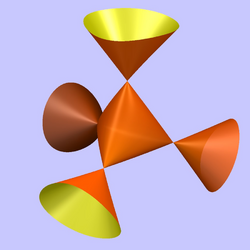Cayley's nodal cubic surface
File:3D model of Cayley surface.stl In algebraic geometry, the Cayley surface, named after Arthur Cayley, is a cubic nodal surface in 3-dimensional projective space with four conical points. It can be given by the equation
- [math]\displaystyle{ wxy+ xyz+ yzw+zwx =0\ }[/math]
when the four singular points are those with three vanishing coordinates. Changing variables gives several other simple equations defining the Cayley surface.
As a del Pezzo surface of degree 3, the Cayley surface is given by the linear system of cubics in the projective plane passing through the 6 vertices of the complete quadrilateral. This contracts the 4 sides of the complete quadrilateral to the 4 nodes of the Cayley surface, while blowing up its 6 vertices to the lines through two of them. The surface is a section through the Segre cubic.[1]
The surface contains nine lines, 11 tritangents and no double-sixes.[1]
A number of affine forms of the surface have been presented. Hunt uses [math]\displaystyle{ (1-3 x-3y-3z)(xy+xz+yz)+6xyz = 0 }[/math] by transforming coordinates [math]\displaystyle{ (u_0, u_1, u_2, u_3) }[/math] to [math]\displaystyle{ (u_0, u_1, u_2, v=3(u_0+u_1+u_2+ 2 u_3)) }[/math] and dehomogenizing by setting [math]\displaystyle{ x=u_0/v, y=u_1/v, z=u_2/v }[/math].[1] A more symmetrical form is
- [math]\displaystyle{ x^2 + y^2 + z^2 + x^2 z - y^2 z - 1 = 0. }[/math][2]
References
- ↑ 1.0 1.1 1.2 Hunt, Bruce (1996). The Geometry of Some Special Arithmetic Quotients. Springer-Verlag. pp. 115-122. ISBN 3-540-61795-7.
- ↑ Weisstein, Eric W.. "Cayley cubic". http://mathworld.wolfram.com/CayleyCubic.html.
- Cayley, Arthur (1869), "A Memoir on Cubic Surfaces", Philosophical Transactions of the Royal Society of London (The Royal Society) 159: 231–326, doi:10.1098/rstl.1869.0010, ISSN 0080-4614
- Heath-Brown, D. R. (2003), "The density of rational points on Cayley's cubic surface", Proceedings of the Session in Analytic Number Theory and Diophantine Equations, Bonner Math. Schriften, 360, Bonn: Univ. Bonn, pp. 33
- Hunt, Bruce (2000), "Nice modular varieties", Experimental Mathematics 9 (4): 613–622, doi:10.1080/10586458.2000.10504664, ISSN 1058-6458, http://projecteuclid.org/getRecord?id=euclid.em/1045759526
External links
- Cayley’s Nodal Cubic Surface, John Baez, Visual Insight, 15 August, 2016
- Cayley Surface on MathCurve.
 |


